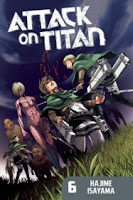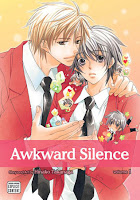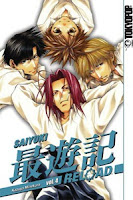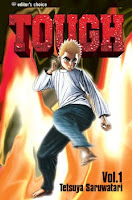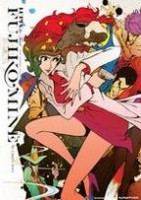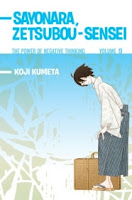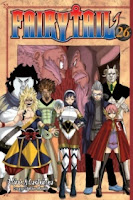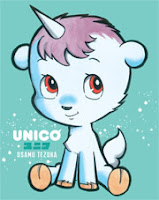My News and Reviews
I posted two reviews here at Experiments in Manga last week. The first was for Yusuke Kishi’s novel of horror and survival The Crimson Labyrinth. Currently The Crimson Labyrinth is the only work by Kishi available in English, but Vertical will begin releasing the manga adaptation of his novel From the New World later this year. (The same From the New World recently had an anime adaptation, too.) I also posted my latest Blade of the Immortal review—Blade of the Immortal, Volume 25: Snowfall at Dawn. The last few volumes of Blade of the Immortal have been building up to the showdown between Shira and Manji; finally the time has arrived when they face each other.
There were a couple of interesting things that I came across online last week. First, there was an interview with Annaliese Christman, a freelance letterer for Viz Media. I didn’t know much about lettering, so I found it to be a very interesting read. The other item I wanted to mention was Dan Kanemitsu’s examination of the impact the upcoming Tokyo Olympics may have on censorship in Japan—Fear and Loathing in the Bold New Olympic Era. (Too long, didn’t read? CBLDF has a nice overview of the article with some additional commentary—Tokyo Olympics Emboldens Censors.)
Quick Takes
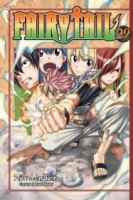 Fairy Tail, Volume 29 by Hiro Mashima. This is only the second volume of Fairy Tail that I’ve had the opportunity to read in its entirety. At this point my general impression is that it’s a fun, but rather generic series. I just can’t seem to shake the feeling that I’ve seen it all before. I do like the variety of magic styles, though. Most of the twenty-ninth volume focuses on the battle between five young members of the Fairy Tail guild and Hades, the guild’s former grandmaster. Although not entirely unexpected, there were some great moments during fight that really show off the group’s teamwork. Fairy Tail moves along quickly with plenty of battles and action sequences. For the most part, Mashima’s art works nicely. However, all of the cuts and scratches that the characters end up with over the course of their fights make them look like they all have scales, which is a little odd. Although for some characters, like Natsu with his dragon abilities, it’s rather appropriate.
Fairy Tail, Volume 29 by Hiro Mashima. This is only the second volume of Fairy Tail that I’ve had the opportunity to read in its entirety. At this point my general impression is that it’s a fun, but rather generic series. I just can’t seem to shake the feeling that I’ve seen it all before. I do like the variety of magic styles, though. Most of the twenty-ninth volume focuses on the battle between five young members of the Fairy Tail guild and Hades, the guild’s former grandmaster. Although not entirely unexpected, there were some great moments during fight that really show off the group’s teamwork. Fairy Tail moves along quickly with plenty of battles and action sequences. For the most part, Mashima’s art works nicely. However, all of the cuts and scratches that the characters end up with over the course of their fights make them look like they all have scales, which is a little odd. Although for some characters, like Natsu with his dragon abilities, it’s rather appropriate.
 Nana, Volumes 16-18 by Ai Yazawa. The more of Yazawa’s manga that I read, the more I am impressed by it. Nana is a fantastic series. The characters are complex and multilayered; the story is dramatic and absorbing without being overwrought. These particular volumes deal just a little less with the music industry and the bands as a whole. Instead, they delve more into the characters’ personal lives. Particularly important is the revelation of Nana and Shin’s pasts as well as their less than ideal family circumstances—something that proves to be very problematic. Also included in these volumes are two lengthy side stories. One shows Nobu and Nana’s relationship back when they were in school together. Similarly, Takumi’s complicated feelings for Reira is the focus of the other. The side stories are a really nice addition to Nana, giving the story even more depth. They show the importance of the characters’ relationships and how they developed over time to become what they are in the series proper. I’m really looking forward to reading the rest of Nana.
Nana, Volumes 16-18 by Ai Yazawa. The more of Yazawa’s manga that I read, the more I am impressed by it. Nana is a fantastic series. The characters are complex and multilayered; the story is dramatic and absorbing without being overwrought. These particular volumes deal just a little less with the music industry and the bands as a whole. Instead, they delve more into the characters’ personal lives. Particularly important is the revelation of Nana and Shin’s pasts as well as their less than ideal family circumstances—something that proves to be very problematic. Also included in these volumes are two lengthy side stories. One shows Nobu and Nana’s relationship back when they were in school together. Similarly, Takumi’s complicated feelings for Reira is the focus of the other. The side stories are a really nice addition to Nana, giving the story even more depth. They show the importance of the characters’ relationships and how they developed over time to become what they are in the series proper. I’m really looking forward to reading the rest of Nana.
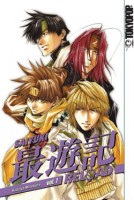 Saiyuki Reload, Volumes 7-9 by Kazuya Minekura. While the early part of the series seemed directionless, by the end of Saiyuki Reload Minekura has a great narrative drive going. Some of the plot elements and storylines do unfortunately seem to have been dropped or forgotten (though perhaps she pulls them all back in for the finale) but the manga does benefit from having a stronger focus. What is particularly interesting about these volumes is that the yokai’s side of the conflict is shown in more detail. Although there have been exceptions, for the most part the yokai have simply been the series’ monsters. Minekura makes it very clear here that the yokai are really not all that different from humans and that it is the humans who are sometimes the real monsters. Looking back, this has actually been one of the recurring themes in the series. Although Saiyuki Reload is ten volumes long, only nine volumes were ever released in English. It’s particularly tragic since the ninth volume ends on one heck of a cliffhanger.
Saiyuki Reload, Volumes 7-9 by Kazuya Minekura. While the early part of the series seemed directionless, by the end of Saiyuki Reload Minekura has a great narrative drive going. Some of the plot elements and storylines do unfortunately seem to have been dropped or forgotten (though perhaps she pulls them all back in for the finale) but the manga does benefit from having a stronger focus. What is particularly interesting about these volumes is that the yokai’s side of the conflict is shown in more detail. Although there have been exceptions, for the most part the yokai have simply been the series’ monsters. Minekura makes it very clear here that the yokai are really not all that different from humans and that it is the humans who are sometimes the real monsters. Looking back, this has actually been one of the recurring themes in the series. Although Saiyuki Reload is ten volumes long, only nine volumes were ever released in English. It’s particularly tragic since the ninth volume ends on one heck of a cliffhanger.
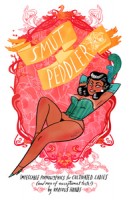 Smut Peddler by Various. Smut Peddler had its beginnings as a three-issue indie minicomic series back in 2003. In 2012, Smut Peddler returned as a full-length anthology collecting twenty-six short erotic comics. Smut Peddler is a phenomenal collection of sex-positive, lady- and queer-friendly comics. I was particularly happy to see the diversity included in the anthology, not only in terms of the characters’ various identities but in genre as well. Smut Peddler contains science fiction and fantasy as well as reality-based works, both historical and contemporary. The stories are short, sexy, and sweet. Some are more serious and others are more humorous, but they are all heartfelt. I was previously familiar with and already follow the work of many of the creators included in the anthology, but there were plenty of artists and writers who I was encountering for the first time. (I now have even more creators I want to seek out.) Work has already begun on a second Smut Peddler anthology, currently scheduled for release in 2014. I can’t wait.
Smut Peddler by Various. Smut Peddler had its beginnings as a three-issue indie minicomic series back in 2003. In 2012, Smut Peddler returned as a full-length anthology collecting twenty-six short erotic comics. Smut Peddler is a phenomenal collection of sex-positive, lady- and queer-friendly comics. I was particularly happy to see the diversity included in the anthology, not only in terms of the characters’ various identities but in genre as well. Smut Peddler contains science fiction and fantasy as well as reality-based works, both historical and contemporary. The stories are short, sexy, and sweet. Some are more serious and others are more humorous, but they are all heartfelt. I was previously familiar with and already follow the work of many of the creators included in the anthology, but there were plenty of artists and writers who I was encountering for the first time. (I now have even more creators I want to seek out.) Work has already begun on a second Smut Peddler anthology, currently scheduled for release in 2014. I can’t wait.
 Velveteen & Mandala by Jiro Matsumoto. Reading Velveteen & Mandala was a rather odd experience for me. I was consistently engaged while I was reading it, but I wasn’t sure that I actually liked it. But after finishing Velveteen & Mandala I couldn’t seem to get it out of my head which to me is a sign of a good manga. The more I think about it, the more I want to read it again—it’s like a lingering and intense fever-dream (or nightmare.) Velveteen & Mandala is a very strange horror manga with strong psychological elements, extremely black humor, frequent pop culture references, and characters who all seem to be at least slightly insane. The ending’s big twist was something that I suspected from the very beginning of Velveteen & Mandala but that doesn’t make it any less effective. Velveteen & Mandala easily earns it’s 18+ rating—it’s gruesome, violent, and sexually explicit. The manga’s off-beat, weird, and bizarre horror and humor definitely aren’t for everyone, but if you can stomach it Velveteen & Mandala is a strangely intriguing work.
Velveteen & Mandala by Jiro Matsumoto. Reading Velveteen & Mandala was a rather odd experience for me. I was consistently engaged while I was reading it, but I wasn’t sure that I actually liked it. But after finishing Velveteen & Mandala I couldn’t seem to get it out of my head which to me is a sign of a good manga. The more I think about it, the more I want to read it again—it’s like a lingering and intense fever-dream (or nightmare.) Velveteen & Mandala is a very strange horror manga with strong psychological elements, extremely black humor, frequent pop culture references, and characters who all seem to be at least slightly insane. The ending’s big twist was something that I suspected from the very beginning of Velveteen & Mandala but that doesn’t make it any less effective. Velveteen & Mandala easily earns it’s 18+ rating—it’s gruesome, violent, and sexually explicit. The manga’s off-beat, weird, and bizarre horror and humor definitely aren’t for everyone, but if you can stomach it Velveteen & Mandala is a strangely intriguing work.

